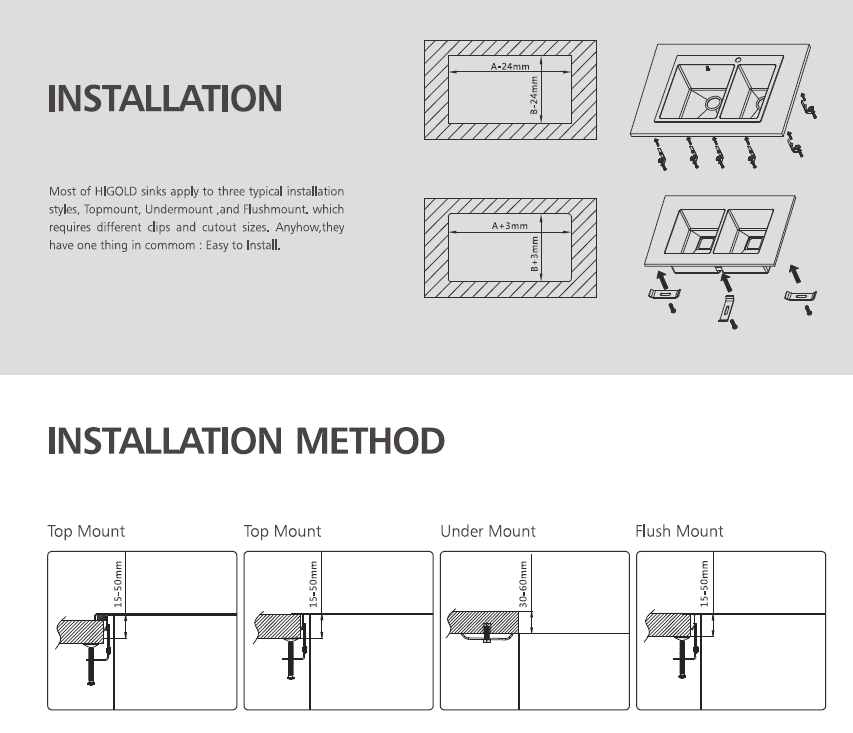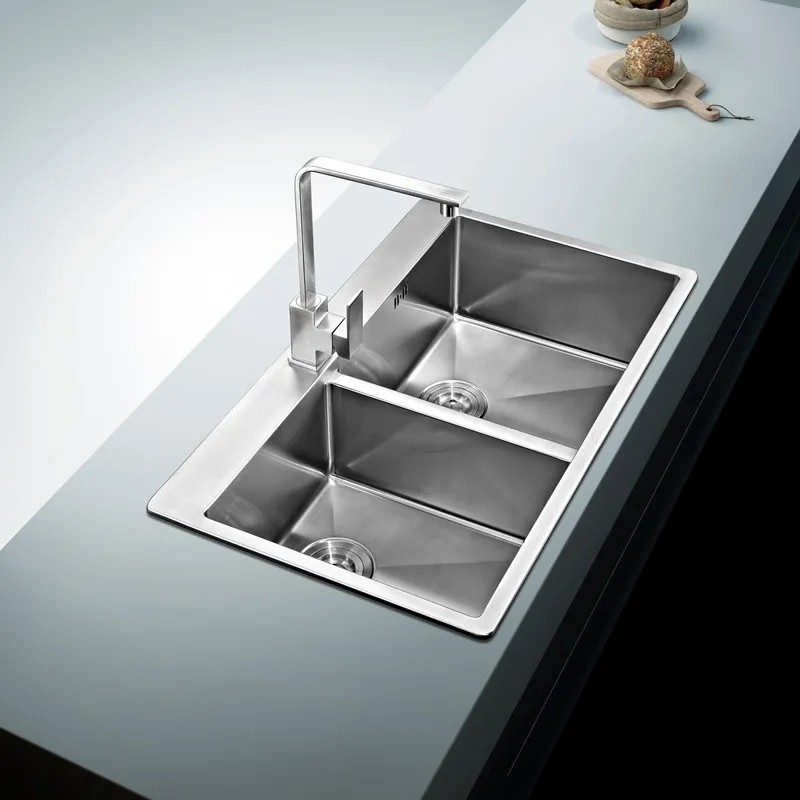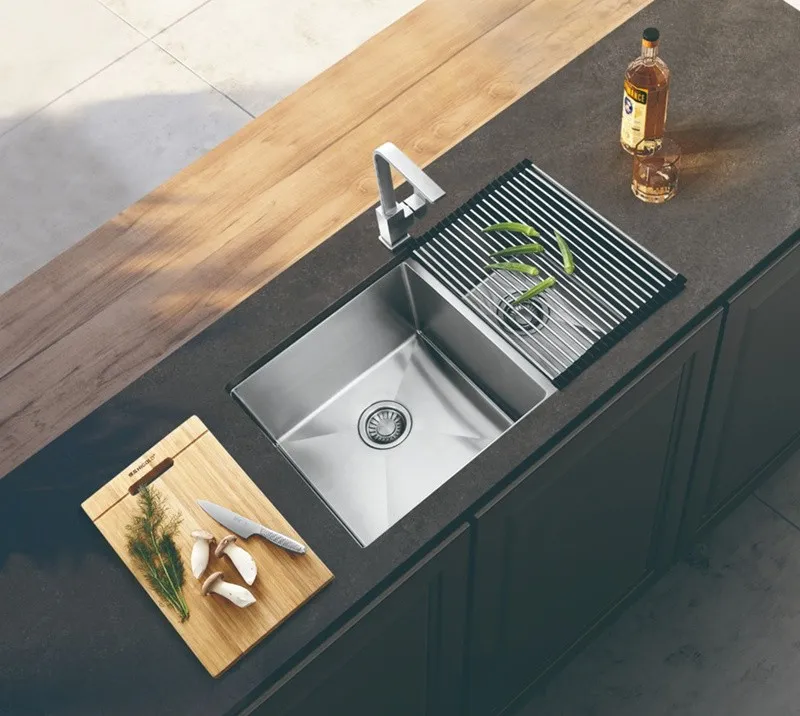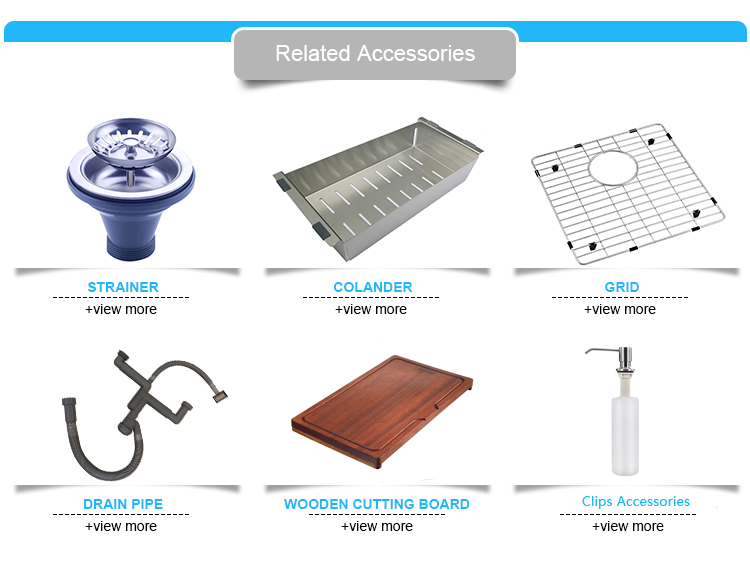Different kitchen sink types require different installation methods. Two common sink installation methods are undermount and recessed sinks. Each has its own advantages and disadvantages and is often chosen as a separate option. An undermount sink's rim sits below the countertop, while a recessed sink is installed above or on the surface of the countertop, with the rim protruding beyond the surface.
However, when choosing a sink, many consumers often wonder, "Can a sink be both built-in and undercounter?" This question prompts in-depth consideration of sink installation options.
In this article, we will explore this question in detail, analyzing the differences between undermount and recessed sinks, the characteristics of these installation methods, and whether a sink can achieve both functions under certain circumstances.
What is the difference between an undermount sink and a recessed sink?
1. Undermount sink
An undermount sink is one in which the rim is installed below the countertop, leaving virtually no gap or seam between the sink and the countertop. The characteristic of this design is that the sink rim is concealed beneath the countertop, creating a smooth transition between the sink and the countertop. This design not only enhances the sink's appearance but also makes cleaning easier, as water flows easily from the countertop into the sink, preventing stains and water spots from accumulating along the seams.
Undermount sinks are commonly used on countertops such as granite, engineered stone, quartz, and stainless steel. Their installation requires expertise, as they require precise fixing and sealing between the sink and the countertop. While undermount sinks require technical expertise, their aesthetic and functional benefits have made them a popular sink installation option in modern kitchens.

2. Recessed sink
A recessed sink is positioned above the countertop, with the rim typically slightly raised above the countertop surface. This means that the rim is visible, and there's a distinct transition between the sink and the countertop. Recessed sinks are relatively simple to design and relatively easy to install. Typically, the sink is placed on a pre-cut countertop and secured with glue or other means.
Compared to undermount sinks, recessed sinks are slightly more difficult to clean because water stains, dirt, and food debris can accumulate between the rim and the countertop. Furthermore, the design of a recessed sink can cause water to splash over the rim, affecting the cleanliness of the kitchen countertop.

Is it possible to design a sink that is both undermount and built-in?
1. Theoretically not possible
Based on the design features and installation methods of undermount and recessed sinks, we can conclude that it is unlikely that a sink can have the characteristics of both an undermount and built-in design. The main reasons are as follows:
· Different design requirements: Undermount sinks require the rim to be completely below the countertop, while recessed sinks must be above the countertop. Therefore, their installation methods inherently conflict. Undermount sinks require the rim to be concealed, while recessed sinks require the rim to be exposed above the countertop.
· Different installation methods: Undermount sinks require the sink to be secured from below the countertop and secured with specialized sealing material to ensure stability and a tight seal. Recessed sinks, on the other hand, are typically installed by placing the sink directly into the cutout, resulting in fundamental differences in their mounting methods and installation techniques.
· Different functional and aesthetic requirements: Undermount sinks pursue a clean and modern aesthetic, seamlessly connecting the sink to the countertop and creating a smooth transition. In contrast, recessed sinks emphasize their edges and are often considered a decorative feature of the kitchen. Therefore, these two installation methods differ significantly in terms of functionality and aesthetics, making it difficult to achieve both in the same sink.
2. Designs that blend the two styles
Although sinks cannot fully combine the functionality of both undermount and built-in sinks, continuous advancements in kitchen design and manufacturing technology have led some designers and manufacturers to explore a fusion between undermount and recessed sinks. Through innovative designs, the sink edge can achieve a certain degree of transition between the countertop and the sink rim. While these installation methods still adhere to the principles of undermount and recessed sinks, through clever design techniques, the sink can achieve a look that combines the clean lines of an undermount sink with the visual appeal of a recessed sink.
This design often manifests itself in the sink's rim. Through precise machining, it creates the appearance of an undermount sink while also retaining some of the characteristics of a recessed sink. For example, some sinks may feature a slightly protruding rim, but not as noticeably as a traditional recessed sink. This maintains the sink's aesthetic while preventing water and food debris from accumulating in the seams.
3. Custom sink options
For some high-end kitchen designs, consumers may choose to customize their sink. By working with the sink manufacturer, consumers may be able to make more adjustments to the design, creating a sink that combines the functionality of an undermount sink with the aesthetics of a recessed sink. While these custom sinks may not be fully integrated into both undermount and recessed installations, they can achieve a certain degree of integration in appearance and function, satisfying consumers' individual design needs.

How to Choose the Right Sink Installation Method?
1. Understand Your Kitchen Design Requirements
When choosing a sink installation method, it's important to first understand your kitchen's design requirements. If your kitchen is small or tends to be modern and minimalist, an undermount sink may be a better choice, as it effectively saves space and creates a seamless visual effect. On the other hand, if your kitchen is larger and prefers a more traditional and decorative feel, a recessed sink may be a more suitable option.
2. Consider the Functional Needs of the Sink
The functional needs of the sink are also an important factor in choosing a mounting method. If you frequently handle heavy pots and pans or larger ingredients, an undermount sink may be more suitable, as it typically provides more space and can be more securely fixed. Recessed sinks are generally suitable for everyday home kitchen use, though they may be slightly more difficult to clean, but are relatively simple to install.
3. Consider the Countertop Material
The compatibility of different countertop materials with the sink will also influence your choice of sink. If your kitchen countertop is made of a harder material like quartz, engineered stone, or marble, an undermount sink will create a smoother transition and won't disrupt the overall aesthetic. On the other hand, if your countertop is made of wood or plastic, a recessed sink may be more suitable, as it can be fixed to the surface, preventing any issues with the countertop material from affecting the sink's stability.

What kind of kitchen faucet options does Higold offer alongside sinks?
Higold’s product line includes a broad range of kitchen faucets to complement its stainless steel sinks. These include pull-out faucets, single-handle mixers, touchless models, and PVD-coated finishes in various colors. All faucets undergo rigorous leak testing and carry international certifications.
Whether you’re supplying commercial kitchens or modern homes, Higold offers faucet models at multiple price points to support all segments of the market.


